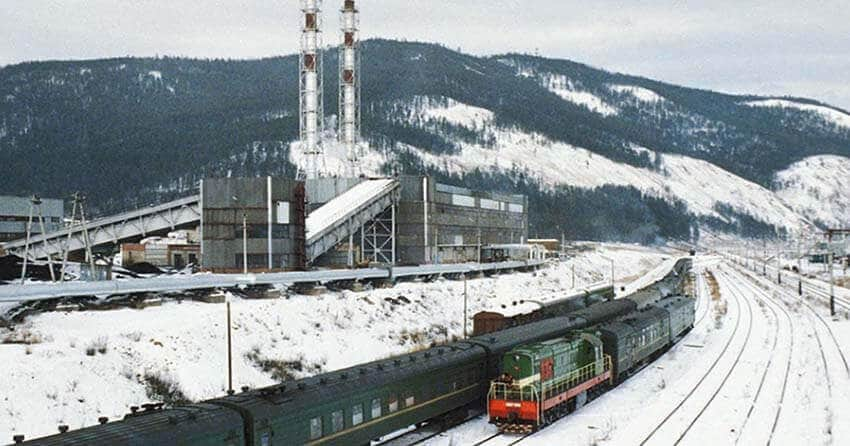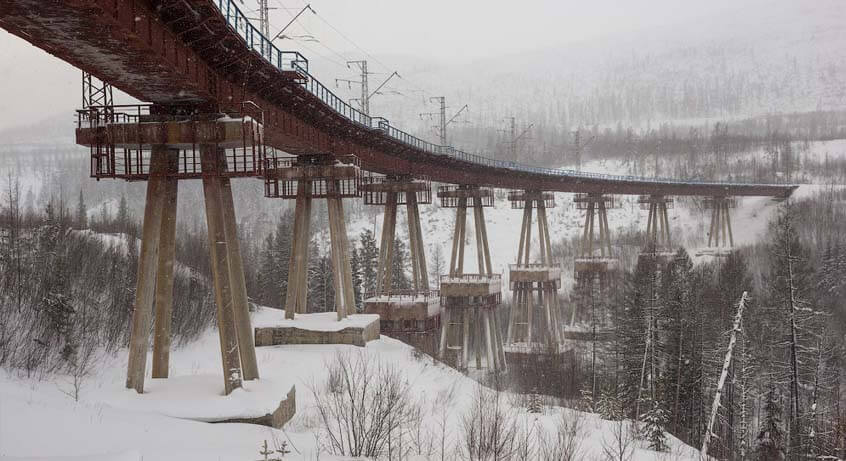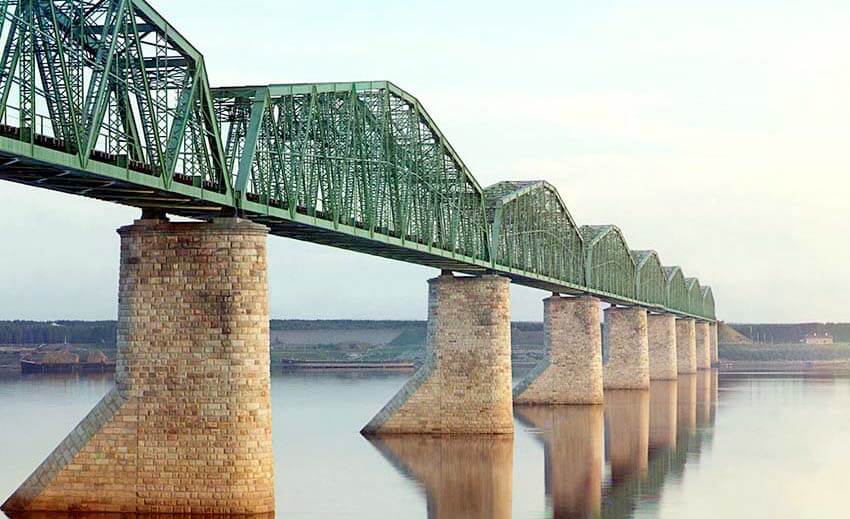Mysterious Siberia and the Baikal Amur Magistral Railways

Mysterious and Inhospitable Siberia, a land mass of 13.2 million sq km, i.e., 9% of the Earth’s dry land, in the 1980’s had a population of just about 27 million people or less than 7 people per sq km. Compared to Siberia, India is just 3.287 million sq km in area but with 1.21 billion people. This huge region is called Sib-ir in Russian which means a Sleeping Land and much of Siberia still remains unexplored.
Lake Baikal which is 1.642 km deep, 500 km long and 62.5 km wide is located in the southern part of Eastern Siberia. It is unique as it is the world’s largest fresh water lake.
The world’s 10th biggest river Amur, originating in Manchuria and ending near Sakhalin Island, flows through Siberia besides some other great rivers like Ob, Yenisei and Lena that all drain into the Arctic Ocean.
Amur River’s speciality fish Kaluga can be as big as 5.6 metres long and weigh over a 1000 kg! There are other fish in this river as well e.g., Arctic Salmon, a fish like the Indian Rahu and a variety of Sturgeon. Amur has the peculiar Siberian characteristic: it does not freeze from the top but from the bottom. It is quite an experience to take a ride on the high speed hydrofoil Raketa boat on this placid river.
Siberia is also known for the mysterious Tunguska explosion of 1908 that had the brilliance of “a thousand Suns” and its sound was heard from over 1000 km. Several million trees were reduced to ashes or uprooted over an area of 2150 sq km. It is estimated to have had the force of a 40 megaton nuclear explosion.
No one knows how it originated. Was it caused by a meteor, a space ship or something else? Nothing unusual was found in its crater and there is no noticeable increase in radioactivity. Scientists the world over have no answer yet for this explosion.
This writer visited this mysterious land in 1981, by flying from Moscow to Khabarovsk that took 7.5 hours in an IL62 jet. By land, it takes over 7 days on the then only Trans-Siberian Railway. The main idea for the visit was not to study the mysteries of Siberia but to see how the Baikal-Amur-Magistral (BAM) railway project was being constructed.
BAM railway was being built as a shorter route, cutting through Siberia and stretching from Lake Baikal to Vladivostok on the eastern coast of Russia. This line was to help construction of houses, settlement of people, exploration of mineral rich Siberia and setting up factories, but above all, to avoid the Chinese threat, apprehended at that time.
The story of American rail-road building is quite well known, but of BAM it is not, being so far away and so secluded from normal human habitation. BAM was easier to plan than to carry out. The project was completed in 1991 after 60 years of relentless effort.

A Baikal Amur Magistral Railway bridge in Siberia
Workers from many parts of Russia as well as from other constituent republics that formed the Soviet Union, at that time, took part in it. BAM is 3200 km long and begins at Tayshet, then crosses the Angara River at Bratsk and the Lena River at Ust-Kut, proceeds past Severobaikalsk at the northern tip of Lake Baikal, past Tynda and Khani, crosses the Amur at Komsomolsk-on-Amur and finally reaches the Pacific Ocean at Sovetskaya Gavan town. This writer visited the project in 1981 when it was just half way through.
Khabarovsk is a major town in Russian Far East strategically situated at the confluence of Amur and Usuri rivers and is just about 30 km from the border with China. It is not a very old town but quite an interesting one.
I went to see the oil refinery here which, at that time, annually processed 4 million tons of crude brought from Vladivostok and Sakhalin Island. This is a major industrial unit in which over 1000 workers were working. The refinery had a sanatorium which workers had to regularly attend for check up.
An interesting thing the chief doctor of the sanatorium told me was that the workers were compulsorily provided with a special “fruit drink” besides other health supplements. This is a cocktail of several fruit juices which at the final stage of preparation is saturated with Oxygen. I also drank it. The concoction leads to a sudden increase of oxygen in the blood stream and makes one feel energetic and exhilarated.
At the Khabarovsk museum, one is greeted by a huge Siberian tiger standing over its prey – a wild boar. The animals were a beautiful work of taxidermy and stuffed as they were, looked life-like. The tiger was almost as big as a buffalo.
The lady director of the museum impishly asked me if the Royal Bengal Tiger was as big as the Siberian. I had one up on her by pointing out that the Royal Bengal Tiger was more graceful and better looking.
Geographically, Siberia is divided mainly into four parts – the icy north, Tundra, Taiga and the warmer zone touching Central Asia, Mongolia and China. From north to south, Siberia is a beautiful essay in climatic vegetation. Far north it is only snow. After the snow line only lichen and moss grows. Tundra comes after that. It is the area of Taiga that also includes parts of Tundra where BAM was being built. This is permafrost zone. Beyond the Tundra is the Taiga and then follow the warmer areas but not in a straight-line division. The Taiga is home to dwarf trees and of course some animals. The BAM passes through the border area between Tundra and Taiga.
Construction in the area I visited is extremely difficult as there is the constant danger of land subsiding due to rise in temperature, for, any build-up on it works like a blanket. In the extreme cold metal also becomes brittle. Tree trunks become as hard as steel. The BAM rails therefore had to be made thicker, wider and higher than normal rails using a special alloy steel that did not become brittle or get twisted in extreme fluctuations of temperature.
In many places the rail tracks were laid after driving hollow piles into the soil filled with kerosene which does not freeze but retains the cold and does not allow the soil around to thaw in warm weather.

BAM: Special Projections in Bridge Piers
Many blocs of houses are also built on the same principle and so are the bridges on rivers. Some bridges have special appendages of triangular projections as after ice and snow melt, the river water moves at great speed and big ice blocks can hit the bridge piers quite hard.
I visited BAM by flying from Khabarovsk in a YAK 42 plane to Chegdomyn town that did not even have a paved runway. This town is about 500 km from Khabarovsk. The BAM construction site was about 50 km from there. After a halt at Chegdomyn town where I had lunch and a short visit to the local museum, I was driven through a forest road raising a lot of dust. After 35 km or so, the first level crossing comes where the road passes the BAM railway line.
While flying to Chegdomyn I saw below, as far as my eyes could see, what looked like a spread-out green carpet. That was the Taiga where the trees are old but virtually of one size as they cannot grow tall due to the permafrost. The area is also very rich in minerals. I saw lumps of ore in the Chegdomyn museum including a big gold nugget and some uncut diamonds.
The enormity of the BAM project in this inhospitable terrain, far from civilisation, can be imagined when BAM building means crossing as many as seven high mountain ranges, some 32 water bodies including nine major rivers with 34 bridges, 4200 smaller bridges, 3200 special engineering structures and 21 tunnels in a total span of only 47 km, one of them being 15 km long under the Severo-Muisky range.
The area is also prone to earthquakes. In 1957, a big earthquake raised the Severo-Muisky range by about 1.5 metres and opened a huge fissure which has since formed into 3.5 km long lake. This danger had to be guarded against while building the BAM.
Some 80,000 workers were engaged in the construction of this rail track. The human needs for this workforce can only be guessed and the logistic to work it out is beyond an ordinary person’s imagination.
After reaching Urgul II station, I joined an information session with the engineer in charge. Urgul meant ‘Water of Deodar tree’. Earlier there was no medicine or doctor available in the entire area and whosoever lived there, drank boiled Deodar leaf water for remission of fever which was endemic there. I was given a ride on the Inspection Coach on the BAM construction line that took me some 10 km from Urgul II station crossing a newly built bridge over the Bureya River.
The temperature variation here was enormous, from -55o C in winter to +45 o C in summer. What is even more interesting was to know that in low temperatures, alcohol is not good for health. Hence most BAM workers preferred repeated cups of tea, especially the Indian tea, to drink while working outside. It was indeed the Indian tea that kept the BAM going!
On the way back to Chegdomyn, the BAM engineer in charge at Urgal II graciously allowed me and a few others to use the BAM coach car instead of the motor vehicle. I got back to Khabarovsk again by a YAK 42 aircraft.
BAM is not only an engineering marvel but also a story of human grit, resourcefulness and above all a measure of man’s perseverance and fight with the odds. By 2008, Siberia’s population had gone up to 40 million showing man’s gradual victory over hostile nature. The Sleeping Land is being woken up. It is truly a brilliant essay of man’s unrelenting efforts to spread its wings into the unknown.
